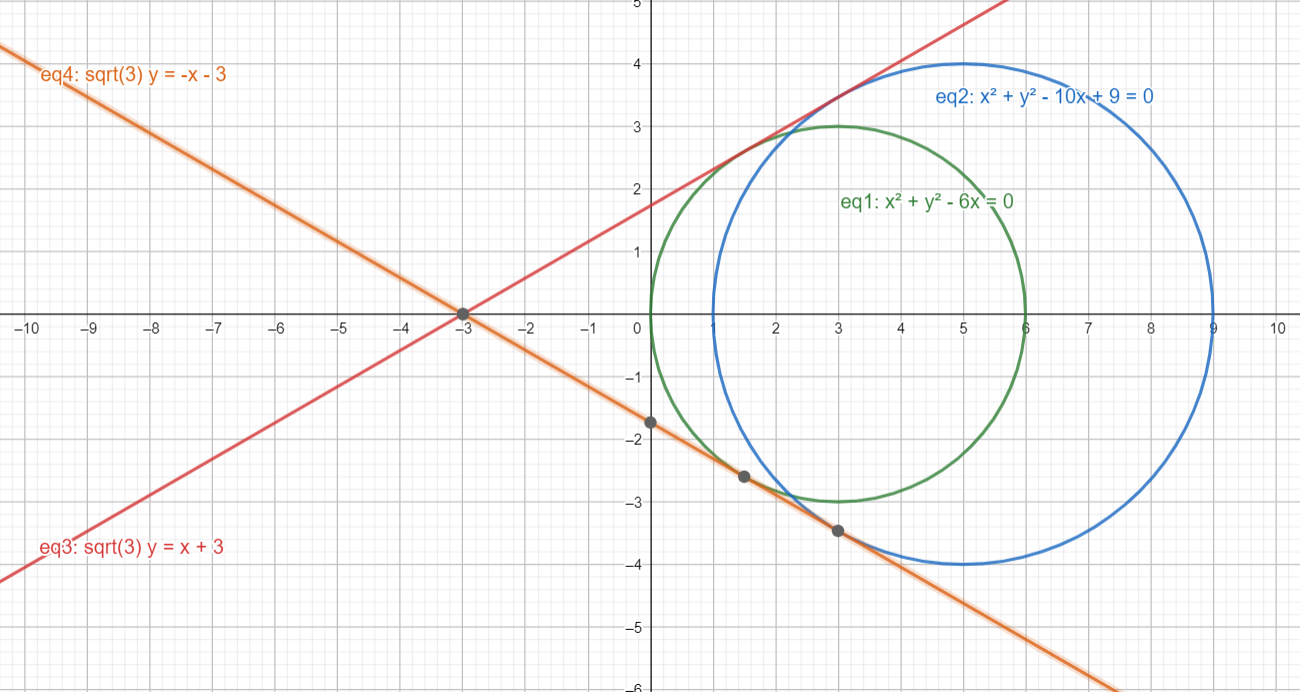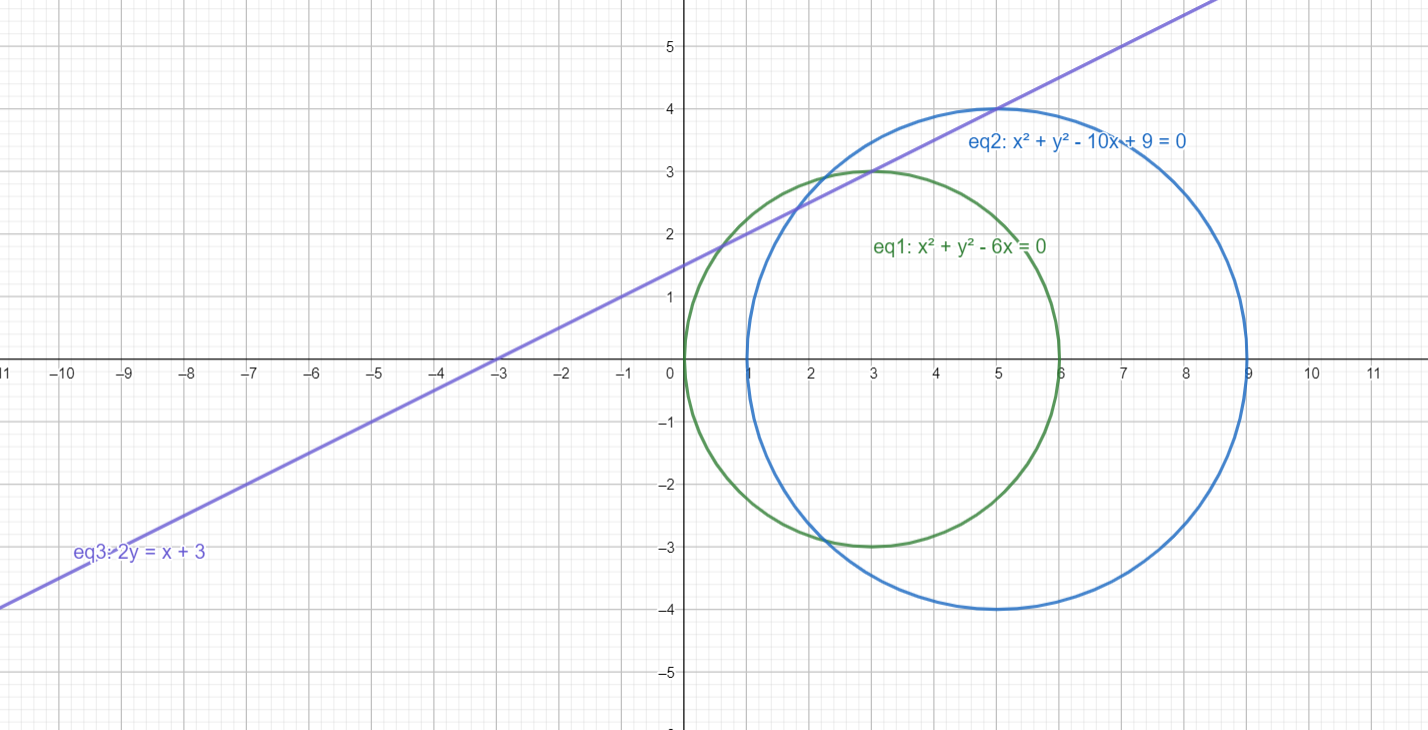
Statement 1
A common tangent to the circles
Statement 2
If two circles touch each other, their radical axis is the common tangent.
(a) Statement -1 is True, Statement 2 is True; Statement 2 is a correct explanation for Statement 1
(b) Statement 1 is True, Statement 2 is true; Statement 2 is NOT a correct explanation for Statement 1
(c) Statement 1 is True, Statement 2 is False
(d) Statement 1 is False, Statement 2 is True
Answer
141.9k+ views
Hint: First find out if the two circles intersect each other, touch each other or don’t touch or intersect each other at all. This would help you to determine the number of common tangents. Use the section formula that will give you the point of intersection of the common tangents. If the tangents are transverse common tangents, then the intersection point will divide them internally in the ratio of their radii, and if they’re direct common tangents, then they’d do the same externally.
The section formula for external division in the ratio m:n is
For internal division, in the ratio m:n, it is $$
After finding the point like this, you can move on to finding the tangents passing through the point.
Complete step-by-step solution -
Let’s call the circle as S1
The general equation of any circle can be written as :
Therefore, for circle S1, comparing the circle’s equation with the general form, we get :
And,
Therefore, the centre of circle S1, C1 =
And its radius
For the circle S2, we again compare its equation with the general form of circles, and see that :
And,
Therefore, the centre of circle S2, C2 =
And its radius
Before determining the common tangents, it is important to find out the number of common tangents these circles have.
We can do so by comparing the distances between the two centres and the sum of their radii.
If
(r1+r2) = 7 and |C1-C2|=
Since the circles intersect, the number of its common tangents will be 2 and both will be direct common tangents.
Next to make our calculations easier, we can find out where the two direct common tangents intersect.
We know that the point of intersection
That is, if we call the point
In the given question, the line joining C1 and C2 is
Therefore, it is safe to assume that point D will be of the form (h,0) since it will also lie on the
According to the rule that states,
We can say that
Therefore, we now have the point of intersection of common tangents D as (-3,0).
We can now proceed with forming a general equation of the common tangents.
Since the common tangents will pass through the point (-3,0),
Their general equation can be written as :
Since the line we just found a general equation of is a tangent to both the circles, it means that the perpendicular distances of the centre of the circles from the line will be equal to their respective radii.
i.e. the perpendicular distance of C1 from the line (1) = r1
and perpendicular distance of C2 from the line (1) = r2
The perpendicular distance d of any point
Like mentioned above, d for C1 = r1.
Squaring both sides, we get :
Doing the same for the circle S2, we’ll have :
Squaring both sides, we get :
Since the values of m got by substituting for both the circles are the same, these values can be substituted in the general of the line that acts as common tangent for both the circles or the line (1).
The general equation of the line we found out was :
Substituting for m, we get two equations :
And
Both the equations mentioned above will act as common tangents for the two circles. Since the equation given in the question does not match either of the equations we’ve reached, we can thus conclude that Statement 1 is False.
As for concluding that Statement 2 is True, when the sum of the radii of two circles is equal to the distance between their centres, it means that both the circles touch each other at exactly one point, and in such cases they have three common tangents.
One of the common tangents is a transverse common tangent and since these two circles touch at exactly one point, the point where the tangent touches the two circles is the same as their own point of intersection.
This common tangent can be found by finding the radical axis of the two circles, provided they touch each other simply by finding the difference of the two circle equations.

Eq4 and eq3 depict the two tangents that we just found out.
Thus, Statement 2 is a True fact.
Hence, answer is (d) Statement 1 is False, Statement 2 is True.
Note: To ease your understanding here is a diagram of the two circles drawn to scale exactly

Here, eq3 shows the equation given in the question. Hence, we can see that this line doesn’t act as a tangent to any of the two circles.
The section formula for external division in the ratio m:n is
For internal division, in the ratio m:n, it is $$
After finding the point like this, you can move on to finding the tangents passing through the point.
Complete step-by-step solution -
Let’s call the circle as S1
The general equation of any circle can be written as :
Therefore, for circle S1, comparing the circle’s equation with the general form, we get :
And,
Therefore, the centre of circle S1, C1 =
And its radius
For the circle S2, we again compare its equation with the general form of circles, and see that :
And,
Therefore, the centre of circle S2, C2 =
And its radius
Before determining the common tangents, it is important to find out the number of common tangents these circles have.
We can do so by comparing the distances between the two centres and the sum of their radii.
If
(r1+r2) = 7 and |C1-C2|=
Since the circles intersect, the number of its common tangents will be 2 and both will be direct common tangents.
Next to make our calculations easier, we can find out where the two direct common tangents intersect.
We know that the point of intersection
That is, if we call the point
In the given question, the line joining C1 and C2 is
Therefore, it is safe to assume that point D will be of the form (h,0) since it will also lie on the
According to the rule that states,
We can say that
Therefore, we now have the point of intersection of common tangents D as (-3,0).
We can now proceed with forming a general equation of the common tangents.
Since the common tangents will pass through the point (-3,0),
Their general equation can be written as :
Since the line we just found a general equation of is a tangent to both the circles, it means that the perpendicular distances of the centre of the circles from the line will be equal to their respective radii.
i.e. the perpendicular distance of C1 from the line (1) = r1
and perpendicular distance of C2 from the line (1) = r2
The perpendicular distance d of any point
Like mentioned above, d for C1 = r1.
Squaring both sides, we get :
Doing the same for the circle S2, we’ll have :
Squaring both sides, we get :
Since the values of m got by substituting for both the circles are the same, these values can be substituted in the general of the line that acts as common tangent for both the circles or the line (1).
The general equation of the line we found out was :
Substituting for m, we get two equations :
And
Both the equations mentioned above will act as common tangents for the two circles. Since the equation given in the question does not match either of the equations we’ve reached, we can thus conclude that Statement 1 is False.
As for concluding that Statement 2 is True, when the sum of the radii of two circles is equal to the distance between their centres, it means that both the circles touch each other at exactly one point, and in such cases they have three common tangents.
One of the common tangents is a transverse common tangent and since these two circles touch at exactly one point, the point where the tangent touches the two circles is the same as their own point of intersection.
This common tangent can be found by finding the radical axis of the two circles, provided they touch each other simply by finding the difference of the two circle equations.

Eq4 and eq3 depict the two tangents that we just found out.
Thus, Statement 2 is a True fact.
Hence, answer is (d) Statement 1 is False, Statement 2 is True.
Note: To ease your understanding here is a diagram of the two circles drawn to scale exactly

Here, eq3 shows the equation given in the question. Hence, we can see that this line doesn’t act as a tangent to any of the two circles.
Recently Updated Pages
Difference Between Mutually Exclusive and Independent Events

Difference Between Area and Volume

JEE Main Participating Colleges 2024 - A Complete List of Top Colleges

JEE Main Maths Paper Pattern 2025 – Marking, Sections & Tips

Sign up for JEE Main 2025 Live Classes - Vedantu

JEE Main 2025 Helpline Numbers - Center Contact, Phone Number, Address

Trending doubts
JEE Main 2025 Session 2: Application Form (Out), Exam Dates (Released), Eligibility, & More

JEE Main Exam Marking Scheme: Detailed Breakdown of Marks and Negative Marking

JEE Main 2025: Derivation of Equation of Trajectory in Physics

Electric Field Due to Uniformly Charged Ring for JEE Main 2025 - Formula and Derivation

Learn About Angle Of Deviation In Prism: JEE Main Physics 2025

Degree of Dissociation and Its Formula With Solved Example for JEE

Other Pages
JEE Advanced Marks vs Ranks 2025: Understanding Category-wise Qualifying Marks and Previous Year Cut-offs

JEE Advanced 2025: Dates, Registration, Syllabus, Eligibility Criteria and More

JEE Advanced Weightage 2025 Chapter-Wise for Physics, Maths and Chemistry

JEE Main 2025: Conversion of Galvanometer Into Ammeter And Voltmeter in Physics

Electron Gain Enthalpy and Electron Affinity for JEE

Electrical Field of Charged Spherical Shell - JEE




